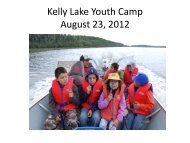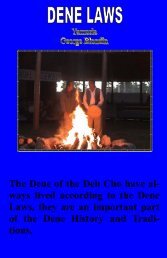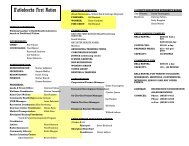NWT 2011-2015 - NWT Species at Risk
NWT 2011-2015 - NWT Species at Risk
NWT 2011-2015 - NWT Species at Risk
You also want an ePaper? Increase the reach of your titles
YUMPU automatically turns print PDFs into web optimized ePapers that Google loves.
6.4<br />
4. D<strong>at</strong>a Sources<br />
Fishes<br />
and Methods – How did we rank species?<br />
Arctic Grayling<br />
Photo Credit:<br />
P Vecsei<br />
Fish are vertebr<strong>at</strong>es, with gills, th<strong>at</strong> live in w<strong>at</strong>er. Three<br />
major groups of fish are recognised: the jawless fishes<br />
(e.g., lampreys), the cartilaginous fishes (e.g., sharks and<br />
sk<strong>at</strong>es) and all the others, bony fishes (e.g., chars, whitefishes,<br />
and herring). Fish are excellent indic<strong>at</strong>ors of w<strong>at</strong>er quality and<br />
ecosystem health. The presence or absence of certain species<br />
can provide immedi<strong>at</strong>e clues about the conditions within<br />
a given area. Fish are one of the most important food and<br />
economic resources in the <strong>NWT</strong>. We are known for our trophy<br />
sized fish, for healthy popul<strong>at</strong>ions, and for delicacies.<br />
In 2010, we reviewed all ranks for freshw<strong>at</strong>er species and<br />
upd<strong>at</strong>ed the list of all marine fishes known to occur in the<br />
<strong>NWT</strong>’s section of the Beaufort Sea and western Arctic Ocean.<br />
Recent work includes the following initi<strong>at</strong>ives.<br />
Diversity of Ciscoes and Lake Trout<br />
Shortjaw cisco is thought to occur in Gre<strong>at</strong> Slave Lake and<br />
possibly in Gre<strong>at</strong> Bear Lake. Work to confirm this was initi<strong>at</strong>ed<br />
on Gre<strong>at</strong> Slave Lake. This work has so far uncovered substantive<br />
and previously unknown diversity of ciscoes in this large lake.<br />
Preliminary results suggest th<strong>at</strong> a shortjaw cisco-like form<br />
occurs, a blackfin cisco-like form and <strong>at</strong> least three other forms<br />
of cisco also occur in one bay of this large lake. Other bays<br />
may hold similar or different forms. Future research is needed<br />
to determine if these ciscoes are distinct species, if they are in<br />
fact shortjaw or blackfin ciscoes, and how they are rel<strong>at</strong>ed both<br />
to each other and to ciscoes found elsewhere. Similar work is<br />
also being conducted in both lakes on diversity of lake trout,<br />
which appears to also exhibit different forms.<br />
Salmon Collection Project<br />
Fisheries and Oceans Canada (DFO) is collecting samples of<br />
salmon for research. The study aims to chart the occurrence<br />
of vagrant salmon and to ultim<strong>at</strong>ely rel<strong>at</strong>e the movement<br />
of salmon in the <strong>NWT</strong> to potential clim<strong>at</strong>ic changes in the<br />
Pacific Ocean and the western Arctic. DFO is working with<br />
local resources councils throughout the <strong>NWT</strong> to obtain as<br />
many samples as possible. Salmon can be turned in for rewards<br />
to local DFO offices, <strong>at</strong>tention to Fisheries Management<br />
staff. Documenting any evidence of occurrence and possible<br />
colonis<strong>at</strong>ion of the western Arctic Ocean by vagrant species<br />
and ultim<strong>at</strong>ely rel<strong>at</strong>ing this to clim<strong>at</strong>e change is a key part of<br />
the study. This will allow for a better understanding of how to<br />
manage new fisheries if they arise.<br />
Research on Broad Whitefish<br />
Broad whitefish is a key food fish of the lower Mackenzie River<br />
basin. Research includes work to understand the different<br />
forms present (lake-dwelling, river-dwelling, and sea-run or<br />
anadromous) and how these mix together when in fresh w<strong>at</strong>er.<br />
This work contributes to better understanding of fisheries and<br />
improves our management of whitefish.<br />
Research on Burbot<br />
Research is being conducted to better understand the ecology of<br />
this common but poorly understood species, which is important<br />
in many local fisheries. Focus of this research is on reproduction<br />
and the importance of sound to their m<strong>at</strong>ing behaviour, as well<br />
as understanding the role of burbot in food webs.<br />
Research on Chars<br />
Both bull trout and dolly varden occupy key habit<strong>at</strong>s within<br />
the Mackenzie River basin, however, their distributions are<br />
poorly known. This project is mapping the distribution of<br />
bull trout in the context of other species of char, such as<br />
dolly varden, and is helping to ensure proper identific<strong>at</strong>ion<br />
of this group of fish. Bull trout is presently being assessed<br />
by COSEWIC. Research on dolly varden in the <strong>NWT</strong> includes<br />
38 <strong>NWT</strong> <strong>Species</strong> <strong>2011</strong>-<strong>2015</strong>









